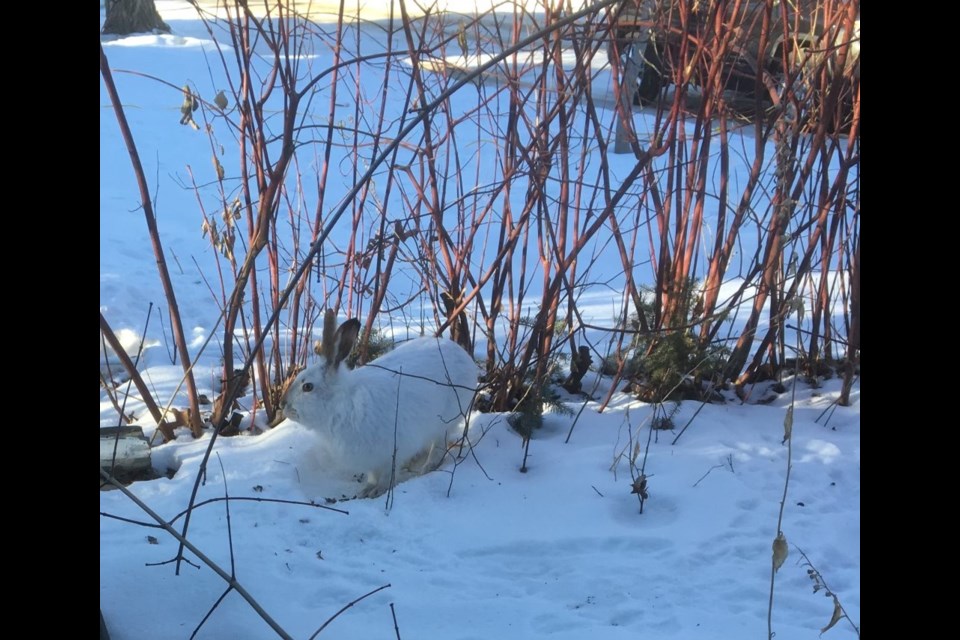When we bought our house in 1987 the front yard was a conventional lawn, with a small horse-shoe shaped flower bed and a large spruce tree. Since then more trees have been added. We planted an Amur maple, oak tree and apple tree; the large spruce was removed, and smaller spruce, a flowering cherry, a mountain ash and an ash tree volunteered to grow. Over the years we also planted a dog wood hedge, forsythia, nine barks, haskap bushes, dwarf lilac, mock orange, barberry and rhubarb. Perennials were also introduced, some of which only lasted a few years because of lack of sun, but now we seem to have reached an equilibrium, with baneberry, valerian, maltese cross, harebells, a few grasses, spirea, growing in the understorey cover of goutweed and ferns.
One reason why I enjoy our wild garden so much is that it is very low maintenance. I pull out noxious weeds such as thistles and creeping bellflower, and remove surrounding plants that are starting to crowd any special favourites, such as the lady’s slipper orchid, gentian and tulips. I prune back robust bushes, if their neighbours need more space, and water very occasionally in a long, dry spell. I like to take a wander through to check on the early spring plants, like cowslips, and later I enjoy the scent of the lilac and mock orange.
There are many animals that share our wild yard. There are birds in the garden all year round, and we encourage their visits with feeders and nest boxes. Woodpeckers, nut hatches, chickadees, house sparrows and house finches are regular daily visitors. This year we also have seen a flicker, and 2 little juncos who stayed all winter. Soon the waxwings will be arriving to eat the mountain ash berries, and once the snow has melted the spring migrants will be scratching in the leaf mat of old goutweed.
When the summer birds return, we specially watch to see which wren boxes will be used. One year the box that was clearly visible from our front window was inhabited, and it was very interesting to see how many twigs were taken into the box, and the contortions that were necessary to wrestle some of the more awkward twigs through the small hole.
As fall approaches the birds, and wasps, will find the apples, and we are careful as we pick them. There are always a few left high up, or on the ground, so we do share amicably. There are hidden haskaps, mountain ash berries, and of course we start to fill up the feeders as the weather gets colder. We are visited by the youngsters of chickadees, nuthatches and other birds. This year we definitely have at least one pair of downy woodpeckers and I hope we will see their youngsters in fall 2023.
During the winter we see the tracks of rabbits and small rodents, and one spring we saw a white rabbit hiding under the bushes –we think it was the Easter bunny! Sometimes the bushes have been pruned back (by rabbits), and our apple tree lost some of the trunk bark many years ago (mouse damage), but everything has managed to survive.
The flowering of the haskap bushes encourages early visits by bees, and the pollination has been excellent resulting in berries to be shared between humans and birds. One year I had not noticed the berries were ripe, until there was much activity in the bushes as the birds got there first.
The bees are always busy in the pink, flowering rose bush that is on the eastern edge of the yard. The predatory, white crab spiders lurk under the flowers, waiting for a meal. The smaller bees are targets for the spiders but the larger bees can forage unscathed. There are always a few roses right until freezing, to feed the bees, and we also have veronica plants that they love.
There used to be milkweed plants in the sunnier spots and one year there were 7 monarch butterfly caterpillars that completed their life cycle in our yard. That was very exciting, but unfortunately the plants died out and I haven’t seen monarchs in our garden since then.
We had an infestation of slugs one year, so many they were trapped daily and removed from the garden, but they have not been a problem since. The ants like to run around on the peonies, which are also susceptible to mildew after flowering. I cut off the infected seed heads and the plants survive to flower another year.
I really hadn’t thought about how many animals live, or pass through, our wild front yard until I started to plan this article. Now I appreciate more than ever the diversity of wildlife that shares our space, enabling us to enjoy the wonders of natural history in our garden.
Jill Thomson is a retired Plant Pathologist who lives in Saskatoon, where she enjoys gardening with her family, including the dogs.
This column is provided courtesy of the Saskatchewan Perennial Society (SPS; [email protected] ). Check our website (www.saskperennial.ca) or Facebook page (www.facebook.com/saskperennial) for a list of upcoming gardening events




